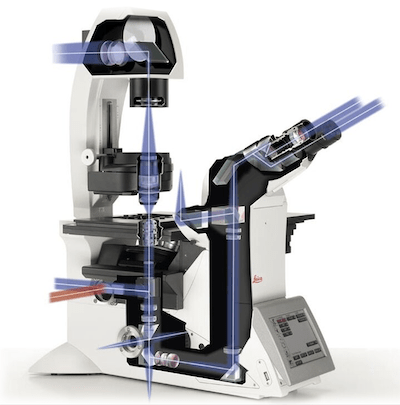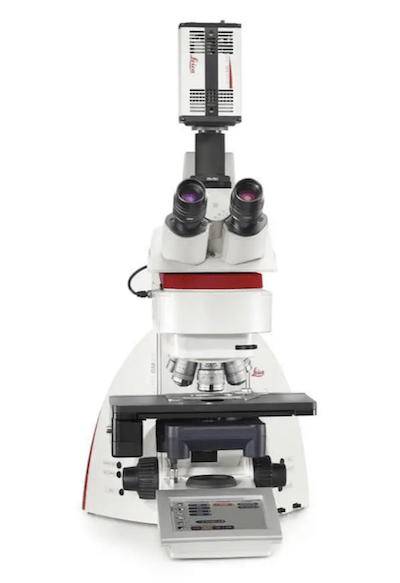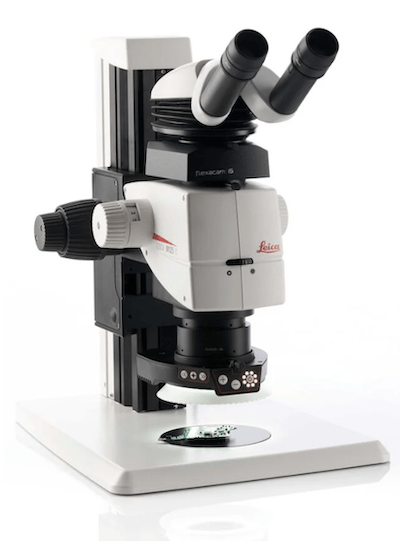Other microscopes
Building: Integrated Science and Technology Center basement, rooms 006 & 008; office, room 013
About the instruments
- Leica DMi8 epifluorescence
- Leica Thunder Imager 3D epifluorescence
- Leica LMD7000 laser microdissection
- Thorlabs optical tweezers system
- Leica M125 stereo microscope
Leica DMi8 epifluorescence

From the manufacturer: "Streamline your complex microscopy workflows with the DMi8 inverted microscope. The platform enables you to reliably generate high-quality data with solutions that you can tailor to your research requirements and budget.
Adaptive immersion technology:
- Employs an embedded sensor to monitor and maintain immersion throughout your experiments.
- Enables you to use optimum water immersion objectives for live cell experiments under physiologically relevant conditions.
- Creates smoother workflows through hassle-free switching to immersion objectives."
Leica Thunder Imager 3D epifluorescence

From the manufacturer: "To answer important scientific questions, THUNDER Imaging Systems enable you to obtain a clear view of details, even deep within an intact sample, in real time without out-of-focus blur. THUNDER brings you high-speed, multicolor imaging of thin and thick samples with increased temporal resolution in the first attempt itself. Sharp imaging of 2D and 3D specimens is as easy as working with your favorite camera-based fluorescence microscope." Learn more.
Leica LMD7000 laser microdissection

From the manufacturer: "Specimen collection by gravity – contact-free and contamination-free. Laser microdissection (LMD) makes it possible to distinguish between relevant and non-relevant cells or tissues. It enables the researcher to obtain homogeneous, ultrapure samples from heterogeneous starting material.
Researchers can selectively and routinely analyze regions of interest down to single cells from all kinds of tissues, even living cells from cell culture, to obtain results that are relevant, reproducible, and specific." Learn more.
Thorlabs optical tweezers system
From the manufacturer: "Thorlabs' OTKB(/M) Modular Optical Tweezers provide users with a tool for trapping and manipulating microscopic-sized objects. These laser-based tweezers, or traps, have been employed in numerous biological experiments. Biological applications for optical tweezers include trapping viruses and bacteria, manipulating cellular structures, patterning of surfaces, and measuring forces of molecular motors and biological molecules such as DNA and proteins.
Our modular optical tweezers have the flexibility required for experiments conducted in advanced research laboratories. The system is based on an inverted microscope design that provides compatibility with standard samples. It is offered with a CMOS camera for video imaging, and the system can be easily adopted for fluorescence, single-molecule, and other types of microscopy. The advantage to purchasing and assembling this modular system is the versatility it provides over other closed optical tweezers systems. Since the optical tweezers are built using standard Thorlabs components, it is easy to modify or upgrade the system using other standard components." Learn more.
Leica M125 stereo microscope

From the manufacturer: "With a coded zoom and apochromatic optics, the Leica M125 C offers high-end quality for mid-range budgets. Combining optimal resolution and depth of field with the integrated double iris diaphragm.
- 12.5:1 zoom
- 8x to 100x magnification
- Up to 864 lp/mm resolution (with 2.0x objective)
Typical applications:
- Medical device manufacturing
- Semiconductor inspection
- Materials science"
Available to Yale researchers & external researchers